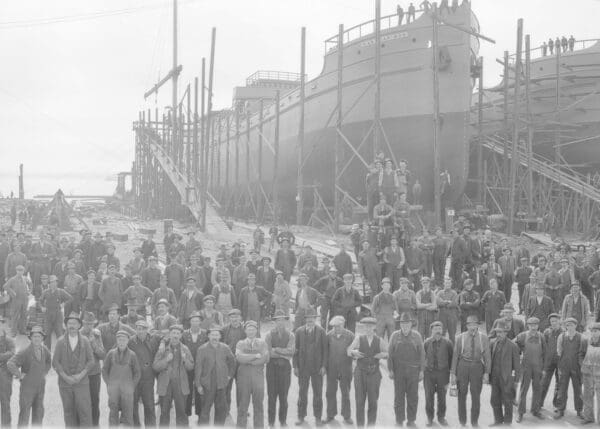01. Shipyard History
History
Located in the San Francisco Bay, Treasure Island is a man-made island that was built in 1936 as the site of the 1939 World’s Fair. The island was then leased to the U.S. Navy to help support World War II (WWII) efforts.
As a naval station, Treasure Island was used as a center for receiving, training and dispatching service personnel as well as an administrative center. Treasure Island Naval Station could process up to 12,000 military personnel per day for service overseas and upon their return to the United States.
Some of the training that was completed at Treasure Island Naval Station included nuclear training, which caused large amounts of toxins to be left in the soil. Many residents of the island claim the toxins left behind have made them sick.
After more than five decades and five wars, Treasure Island Naval Station was closed in 1997 as part of the Base Realignment and Closure program. Today, the island is dealing with radioactive cleanup while also undergoing a $6 billion redevelopment plan. The EPA had considered the shipyard to become a Superfund site, but it did not get added to the National Priorities List. Treasure Island is under redevelopment for 8,000 new homes, a hotel, a new ferry terminal and retailers while also undergoing a large-scale radiation cleanup.
Treasure Island Naval Station History at a Glance
- Other Names: Naval Station Treasure Island
- Location: San Francisco Bay
- Owner(s): Federal Government, City of San Francisco, Treasure Island Development Authority, U.S. Department of Labor, U.S. Coast Guard and the Federal Highways Administration
- Years of Operation: 1941 – 1997
- Wartime Operations: World War II (WWII), Cold War, Korean War, Vietnam War and the Persian Gulf War
- Size of Shipyard: 1,079 acres
- Noteworthy Ships: USS Boston, USS Arlington, USS Haynsworth, USS Pyro, SS Delta Queen, USS Independence
- Types of Ships Built/Serviced: Minesweepers, patrol crafts, destroyers
Many workers at Treasure Island Naval Station were potentially exposed to asbestos. Workers’ loved ones may have also experienced secondhand exposure. As a result, many people developed asbestos-related diseases, such as asbestosis, asbestos lung cancer, and pleural and peritoneal mesothelioma. People who developed an asbestos-related disease may be eligible for compensation.
Notable Ships Built and Repaired
Ships at Treasure Island Naval Station were used for receiving and training purposes. However, they did have distinguished histories outside of their service at the Naval Station. Notable ships include the USS Haynsworth, USS Arlington and USS Independence, which was also relevant at nearby Hunters Point Naval Shipyard.
USS Haynsworth
USS Haynsworth was a destroyer that was launched in 1944 by the Federal Shipbuilding & Drydock Company in Kearny, New Jersey. She took part in the final assaults against Japan during WWII in 1944 and 1945. In April 1945, the USS Haynsworth was attacked by a kamikaze and was sent to Mare Island for repairs. After repairs, she spent two months at Treasure Island Naval Station as a training ship before being part of the Reserve Fleet and a training boat until the Korean War.
During the time of the Korean War, USS Haynsworth spent time in the Mediterranean. After the war, some of her missions included peacekeeping efforts in the Pacific and Mediterranean in the 1950s and 1960s. She also was involved in the evacuation of U.S. nationals from Egypt in 1958 and the naval quarantine of Cuba in 1962. USS Haynsworth was decommissioned in 1970 and transferred to Taiwan where she was recommissioned as Yuen Yang.
From the year she was built to the year she was decommissioned in the U.S., asbestos was used aboard the USS Haynsworth. This put anyone on board who was working or training at risk of developing mesothelioma.
USS Arlington
SS Fred Morris was a cargo ship built in 1942 by the Consolidated Shipbuilding Corp. in Wilmington, California. SS Fred Morris was converted at the Todd Shipbuilding & Drydock Co. in Hoboken, NJ and renamed USS Arlington in 1944.
The USS Arlington spent time in Seattle in 1944 as a training ship. At the end of that same year, she served as a training ship at the Pre-Commissioning Center for auxiliary ships at Treasure Island through the end of the war. Her last trainee crew left the ship in September 1945.
The ship trained approximately 25,000 men at Seattle and Treasure Island. Relieved of instructional duty in 1945, USS Arlington was assigned to Service Force, Pacific, for duty in Magic Carpet, the return of servicemen to the U.S. She sailed for Okinawa, Tokyo, and Yokosuka, Japan, with 1,400 troops embarked, ultimately returning to Seattle in November for repairs and upkeep. Decommissioned in 1946, USS Arlington was transferred to the War Shipping Administration. Renamed Fred Morris, the ship remained under government ownership into the 1960s. Laid up around 1950, she remained inactive until scrapped in Baltimore, Maryland, in February 1965.
In the 1940s, asbestos was used in commercial and Navy shipbuilding, conversion and repair. This put all workers, crew members and service members on board the SS Fred Morris/USS Arlington at risk of developing asbestos-related diseases from the time she was constructed to the time she was scrapped.
02. Shipyard Asbestos Use
Asbestos Use at Treasure Island Naval Station
Asbestos was used to manufacture many products. It was a popular additive because it increased the durability and heat resistance of substances. Such products were ideal for use in the harsh environments often present in the shipping industry.
Treasure Island Naval Station was in operation from 1941 to 1997. Asbestos use was common during much of this timeframe. The dangerous mineral was often present in items such as boilers, incinerators, insulating materials and other elements of ships. This means people who worked in shipyards have a high risk of asbestos exposure and of developing asbestos-related diseases.
Asbestos Exposure at Treasure Island Naval Station
Members of the U.S. military and civilians provided labor in shipyards and on ships. Asbestos was used in most shipyards, including Treasure Island Naval Station, and aboard most vessels from the 1930s to the 1980s. This likely exposure puts Navy veterans at an increased risk of malignant mesothelioma cancer.
People who constructed or maintained minesweepers, patrol crafts, destroyers and other types of ships during this time were likely exposed to asbestos. These people often worked in space-constrained and poorly ventilated areas, which possibly allowed more asbestos fibers to remain in the work areas. For example, steamfitters faced asbestos exposure.
Starting in the 1980s, most newly manufactured products did not contain asbestos. However, anyone who continued working in the shipping industry risked exposure to asbestos. That exposure could occur through legacy asbestos materials. Many shipyard duties, including insulating the ship, maintaining boilers and installing pipes, exposed people to asbestos.
03. Asbestos Lawsuits
Asbestos Lawsuits and Settlements
Anyone who spent time at Treasure Island Naval Station and developed asbestos cancer or another asbestos-related disease has potential compensation options. The companies who manufactured the products that exposed these people to asbestos can be held responsible.
How an individual can be compensated depends on the status of the responsible company. A mesothelioma lawyer can help the victim secure compensation through a lawsuit, settlement, VA claim and/or trust fund claim (or a combination of these options).
Holding Asbestos Companies Responsible
Some asbestos-producing companies are still operational and have not filed for bankruptcy. Individuals can still file lawsuits against such companies. Asbestos lawsuits can result in verdicts or settlements.
For example, people using products from Velan Valve Corporation were exposed to asbestos. Navy personnel who serviced valves associated with hotel services (hot water, cold water, plumbing and sewage) have had asbestos exposure from repacking of the valves.
Another viable company, York International Company, wrongfully exposed ship and shipyard workers to asbestos through their air-conditioning and refrigeration equipment. During World War II, York installed air-conditioning and refrigeration equipment aboard the ships of six countries and at military sites ranging from headquarters operations to strategic outposts and the front lines. The company’s naval training school graduated 1,200 petty officers trained to operate and maintain refrigeration and air-conditioning machinery aboard ships. This left many people at risk of developing asbestos-related diseases such as mesothelioma.
Some victims have filed successful lawsuits against these companies.
04. Filing Asbestos Claims
Asbestos Company Trusts
After exposing many people to asbestos and dealing with the associated mesothelioma claims, more than 100 companies have filed for bankruptcy since the 2000s. As part of their bankruptcy filings, many of these asbestos companies created trust funds to compensate current and future victims of asbestos diseases.
Many Navy veterans, shipyard workers and others have developed asbestos-related illnesses after asbestos exposure on the job. Victims can seek compensation by filing a claim against the responsible asbestos manufacturer’s trust fund.
Asbestos Company Trust Funds and Eligible Years of Employment
The following companies provided asbestos products to Treasure Island Naval Station. After facing many asbestos lawsuits and exposing innocent people to asbestos, these companies filed for bankruptcy and created trusts to pay victims. If an individual worked at Treasure Island Naval Station and developed a disease such as mesothelioma, they may be able to file a claim against these companies’ trusts.
| Asbestos Trust Funds & Eligible Years of Employment | ||
|---|---|---|
| Asbestos Company Name | Eligibility Start Date | Eligibility End Date |
| AC&S, Inc. | 5/1/1968 | 12/31/1982 |
| Owens Corning | 1/1/1941 | 12/31/1982 |
| Plant Insulation | 1/1/1948 | 12/31/1978 |
| Western MacArthur | 1/1/1944 | 12/31/1982 |




